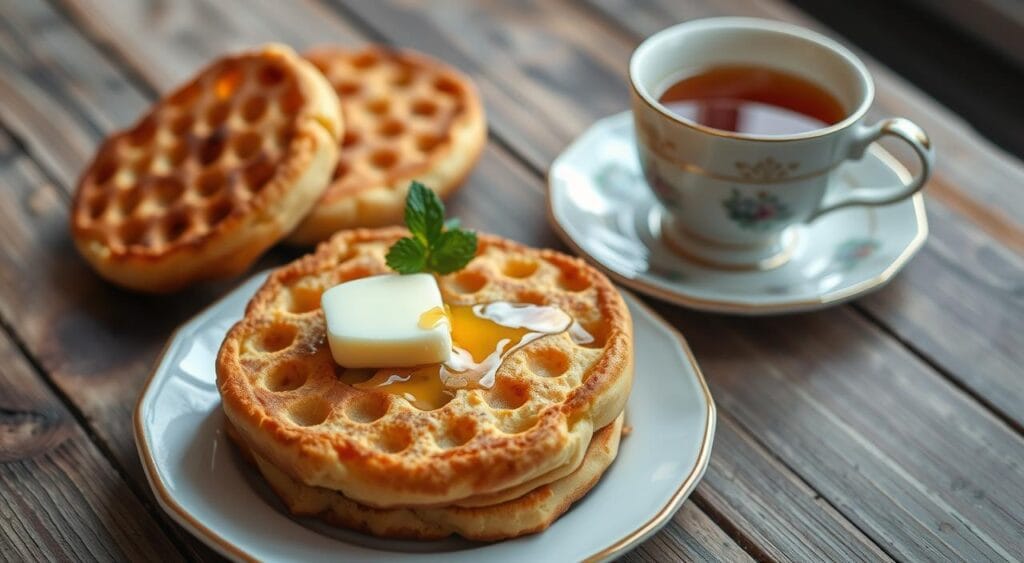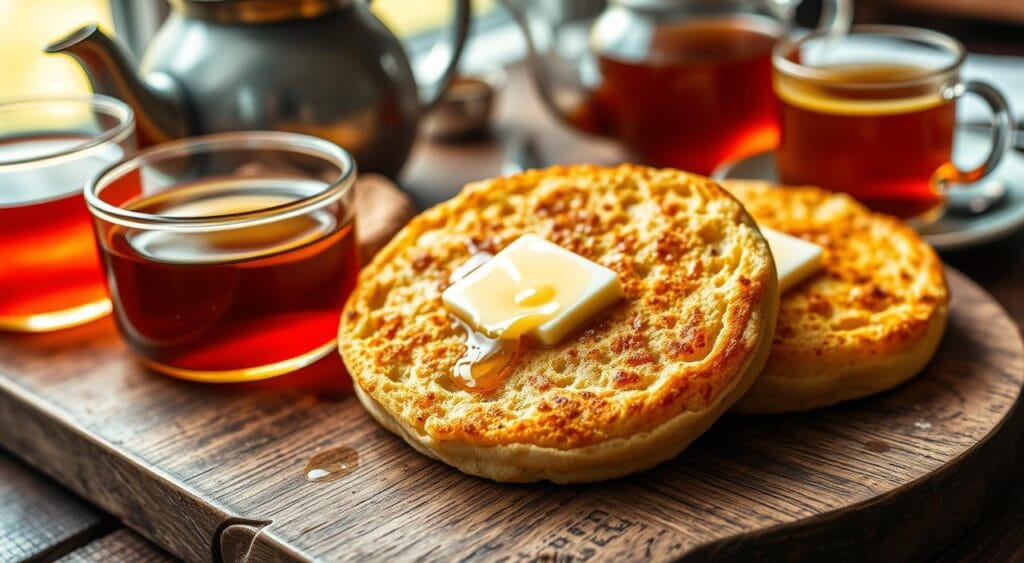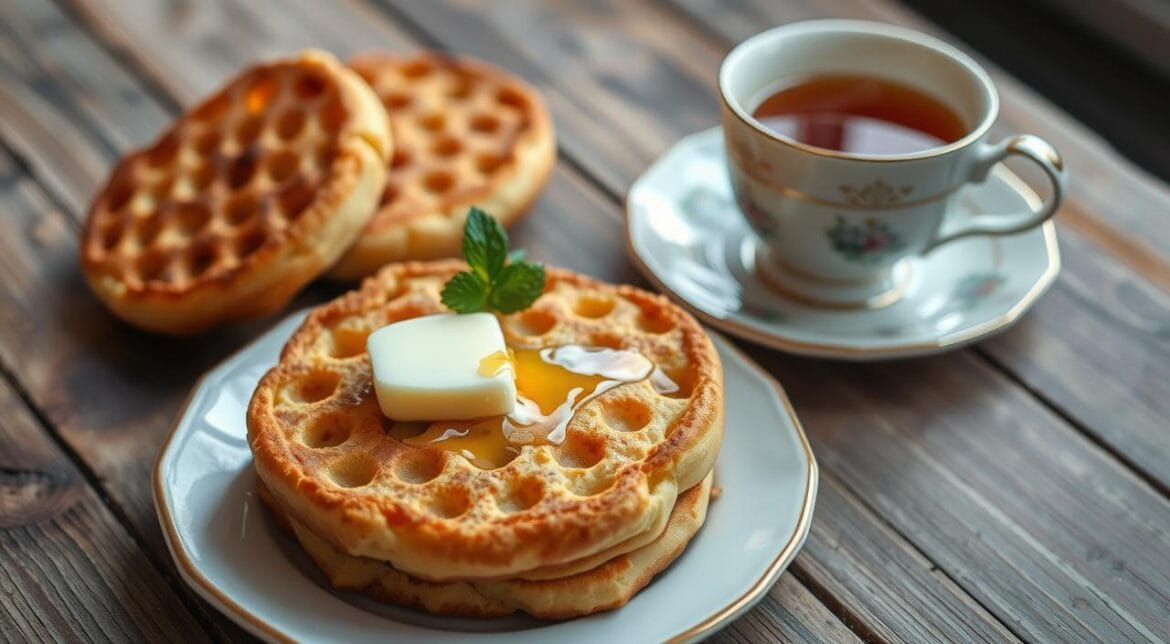Table of Contents
Crumpet Recipe from Great British Chefs : Crumpets are a favorite in British food circles. These spongy breakfast treats have been loved for generations. The recipe from Great British Chefs brings authentic British taste to your kitchen.
Learning to make crumpets shows off British baking skills. The recipe guides you through every step for a classic crumpet. It’s perfect for an English breakfast or a cozy British treat.

Key Takeaways
- Discover the authentic crumpet recipe from the renowned chefs at Great British Chefs
- Explore the rich history and cultural significance of the beloved British crumpet
- Learn the essential ingredients and equipment needed for making perfect crumpets at home
- Master the techniques for mixing, proofing, and cooking crumpets to achieve the perfect golden-brown results
- Discover traditional and modern topping ideas to elevate your crumpet experience
Understanding the History of British Crumpets
Crumpets, those iconic British baked treats, have a rich history. It goes back to the Victorian era. These delightful, spongy discs are a big part of crumpets uk cuisine and british baking recipes. Their story shows how British culinary traditions have evolved.
Origins in Victorian England
The modern crumpet started in the early 19th century. It was a staple in Victorian England’s tea houses and bakeries. The original crumpets were simple, yeast-based creations. They were often served warm with butter, loved by both the working class and aristocracy.
Evolution of the Modern Crumpet
Over the years, the humble crumpet has changed a lot. Today’s crumpets are fluffier and have more nooks and crannies. This makes them perfect for holding melted butter or toppings. This change has kept crumpets popular in the UK.
Cultural Significance in British Cuisine
Crumpets are more than just food; they’re a big part of British culture. They’re often enjoyed during the British tea time ritual. Served with a steaming cup of tea, they add to the cozy atmosphere. The british baking recipes for these treats have been passed down for generations. This has made crumpets a cherished tradition in the UK.

“Crumpets are not just a food, but a symbol of the enduring spirit of British culture.”
Essential Ingredients for Perfect Crumpets
Learning to bake delicious crumpets starts with knowing the right ingredients. These ingredients are key to their unique texture and taste. Mary Berry, a famous British chef, helps us understand what makes a crumpet recipe great.
The base of a perfect crumpet is the flour. Mixing all-purpose flour with bread flour gives the right gluten. This makes the crumpets soft and light inside. Yeast is also important. It makes the crumpets rise and creates their special holes.
- All-purpose flour
- Bread flour
- Active dry yeast
Milk and butter add richness and a hint of sweetness to the batter. Baking soda is crucial for the crumpets’ unique texture. It helps create the “nooks and crannies” that make them so appealing.
- Whole milk
- Unsalted butter
- Baking soda
Choosing and mixing these ingredients carefully will help you make crumpets that Mary Berry would be proud of. Next, we’ll explore the tools and techniques needed to make these British treats.
“The key to an exceptional crumpet is using high-quality ingredients and paying close attention to the preparation process.”
–Mary Berry, renowned British chef and author
Equipment You’ll Need for Making Crumpets
To make homemade crumpets, you need the right tools. From traditional crumpet rings to modern cooking surfaces, the right equipment is key. It helps achieve that fluffy, golden-brown texture. Let’s look at the essential items you’ll need to make the crumpet recipe from Great British Chefs.
Traditional vs Modern Crumpet Rings
Crumpet rings are a must in British kitchens. These circular molds, usually made of metal, shape the batter into the signature round form. Traditional rings have a simple design, while modern ones may have removable bottoms for easy release. Make sure to grease the rings well to prevent sticking.
Griddle and Pan Selection
Finding the perfect cooking surface is crucial for even cooking. A sturdy, heavy-duty griddle or non-stick pan is best. It ensures heat is distributed evenly. Avoid thin pans that can cause hot spots and uneven browning. A griddle with adjustable burners helps control the cooking process.
Temperature Control Tools
- Instant-read thermometer: It’s key to monitor the cooking surface and batter temperature for consistent results.
- Oven thermometer: Make sure your oven is accurately calibrated for proofing the crumpet batter.
- Timer: Use it to set precise cooking times to avoid over or undercooking your crumpets.
With the right equipment, you’ll master the crumpet recipe from Great British Chefs. You’ll make delicious, professional-quality crumpets in your kitchen.
Mastering the Crumpet Recipe Great British Chefs Style
If you love British crumpets, you’ll be excited to learn the secrets from top chefs. By using the Great British Chefs’ method, you can make the best crumpets at home. They offer a delicious taste of British baking.
The Great British Chefs’ recipe focuses on careful preparation and detail. They choose the best ingredients and control the cooking temperature. This ensures the perfect texture and flavor. Let’s explore the key steps to become a crumpet-making expert.
Mixing the Batter
The batter is the heart of a great crumpet. Great British Chefs stress the need for the right mix of flour, yeast, and water. Here’s how to mix the batter perfectly:
- Sift the flour into a large bowl to aerate it and remove any lumps.
- Activate the yeast by combining it with warm water and letting it proof for 10 minutes.
- Gradually whisk the yeast mixture into the flour, creating a smooth, pourable batter.
- Cover the bowl and let the batter rest for at least 30 minutes to allow the gluten to develop.
Proofing the Batter
Proper proofing is key for the crumpet’s airy texture. Great British Chefs suggest proofing the batter in a warm, draft-free spot for up to an hour. This makes the batter double in volume and become bubbly.
“The secret to perfectly proofed crumpet batter is patience and careful attention to every detail. Don’t rush this step – it’s essential for unlocking the full flavor and texture potential of your homemade crumpets.”
After proofing, you’re ready to cook your crumpets to British baking recipes perfection.
Step-by-Step Mixing and Proofing Techniques
Making the perfect crumpet needs careful attention to mixing and proofing. Whether you’re using a crumpet recipe from the Great British Chefs or trying your own, these steps are crucial. They help you get the crumpet’s airy and spongy texture.
Creating the Perfect Batter Consistency
The batter is the base of a great crumpet. You need to mix flour, yeast, and liquid ingredients just right. Start by whisking dry ingredients like flour, baking powder, and salt until they’re well mixed.
Then, add wet ingredients like milk, water, and melted butter slowly. Mix until the batter is smooth and lump-free. It should be thick yet pourable, similar to pancake batter.
Optimal Proofing Times and Temperatures
- Letting the batter proof is key for the crumpet’s texture. Cover the bowl and let it rest in a warm, draft-free spot for about 30 to 45 minutes.
- The best proofing temperature is between 75°F and 85°F. This helps the yeast work and creates the bubbles that make the holes and spongy texture.
- Watch the batter closely during proofing. Over-proofing can make it collapse. Aim to catch it at its peak rise, just before it starts to fall.
Mastering mixing and proofing will help you make crumpets that are a joy to look at and taste. They’ll be a true delight.
Cooking Methods for Golden-Brown Results
Getting your traditional English breakfast crumpets golden-brown and crispy is key. We’ve gathered cooking methods and techniques to help you achieve this. Your homemade crumpets will look perfect every time.
Mastering the Griddle
The griddle is the best way to cook crumpets. It heats evenly and lets you cook many at once. Preheat it to medium-high and grease it with butter or oil.
Put your crumpet rings on the griddle. Cook for 5-7 minutes on each side. Flip them gently to keep the honeycomb texture.
The Skillet Approach
If you don’t have a griddle, a skillet works great. Heat it to medium and grease it with butter or oil. Place the crumpet rings in the pan.
Cook for 4-6 minutes on each side. They should be golden-brown and cooked through.
| Cooking Method | Temperature | Cook Time per Side |
|---|---|---|
| Griddle | Medium-High | 5-7 minutes |
| Skillet/Frying Pan | Medium | 4-6 minutes |
Consistent heat and gentle flipping are crucial. With practice, you’ll make delicious crumpets every time.
“The true test of a great crumpet is the perfectly crisp exterior that gives way to a soft, airy interior.” – Chef Emilia Clarke, British Culinary Expert
Common Mistakes to Avoid When Making Crumpets
Making perfect crumpets is a delicate task. Even skilled bakers can face common problems. Knowing these issues and how to fix them ensures your crumpet recipe from Great British Chefs is always perfect.
Troubleshooting Batter Issues
Getting the batter right is key in crumpet-making. If it’s too thin, your crumpets might not hold their shape and could have too many holes. On the other hand, a too-thick batter makes crumpets dense and heavy. Here’s how to get it just right:
- Measure your ingredients precisely, following the recipe closely.
- Knead the dough well to develop the gluten, resulting in a smooth and elastic texture.
- Allow the batter to rest and proof for the recommended time, which helps develop the crumpet’s signature holes.
Temperature Control Problems
Controlling the temperature is crucial for baking crumpets to perfection. If the surface is too hot, the outside will burn before the inside is cooked. If it’s too cool, your crumpets will be pale and doughy. Here’s how to manage the temperature:
- Invest in a reliable griddle or pan that heats evenly.
- Use a digital thermometer to ensure the cooking surface is maintained at the optimal temperature, typically around 375°F (190°C).
- Adjust the heat as necessary to keep a consistent temperature during cooking.
By avoiding these common mistakes and using the right techniques, you’ll make crumpets that meet the Great British Chefs standards.
Traditional and Modern Crumpet Toppings
Crumpets are a staple in British comfort foods. They’re perfect for showing off a wide range of toppings. From old favorites to new trends, you can make your recipe crumpets with caviar or try other british comfort food ideas.
Here are some classic and modern toppings to turn your crumpets into amazing dishes:
- Butter – A simple pat of butter highlights the crumpet’s texture.
- Jam or Marmalade – Sweet flavors like strawberry or orange marmalade contrast nicely with the savory crumpet.
- Honey – Golden honey on a warm crumpet is a sweet and cozy mix.
- Cheese – Sharp cheddar, creamy brie, or tangy goat cheese make crumpets even better.
- Smoked Salmon – Add silky-smooth smoked salmon and crème fraîche for a luxurious touch.
- Caviar – For a special treat, top your crumpet with caviar for a rich British comfort food experience.
| Topping | Flavor Profile | Texture |
|---|---|---|
| Butter | Rich, creamy | Smooth, melty |
| Jam/Marmalade | Sweet, fruity | Spreadable, chunky |
| Honey | Sweet, floral | Viscous, drizzly |
| Cheese | Savory, tangy | Melty, gooey |
| Smoked Salmon | Savory, smoky | Silky, delicate |
| Caviar | Salty, briny | Firm, bursting |
Crumpets offer a wide range of toppings, from comforting classics to luxurious treats. Try different combinations to find your favorite british comfort food dishes.
“A crumpet is a blank canvas, waiting to be adorned with the most tantalizing toppings.” – British Culinary Historian
Storage Tips and Reheating Methods
Homemade crumpets are a delightful UK cuisine staple. Proper storage and reheating are key to keeping their texture and flavor. These tips will help you enjoy your crumpets at their best.
Freezing and Thawing Guidelines
To store crumpets for a long time, freezing is great. Cool them down first, then put them in an airtight container or freezer bag. To thaw, let them sit at room temperature or refrigerate overnight. Don’t refreeze thawed crumpets to keep their texture.
Best Practices for Freshness
- Store crumpets at room temperature in an airtight container or bread box for up to 3 days.
- Refrigerate crumpets to extend their shelf life by up to 1 week.
- Reheat crumpets in the toaster, oven, or cast-iron skillet to restore their warm, crisp exterior and soft, spongy interior.
- Avoid storing crumpets in the refrigerator for extended periods, as this can dry them out and compromise their texture.
By following these tips, you can enjoy homemade crumpets anytime. They’ll stay delicious, just like when you first made them.
Serving Suggestions and Pairing Ideas
Make your English breakfast even better with British comfort food like crumpets. These golden treats are great for breakfast, snacks, or as a side dish. They add a special touch to any meal.
For a perfect crumpet, try pairing it with tasty flavors and drinks. For a classic English breakfast, add creamy butter, honey, or tangy marmalade. This mix of sweet and savory is a hit.
Want to make your crumpets even more special? Serve them with cheeses like brie or cheddar. Enjoy with a warm English breakfast tea or a strong espresso. It’s a luxurious treat.
For a savory twist, top crumpets with scrambled eggs, bacon, or mushrooms. The choices are endless! No matter what you choose, the British comfort food charm of crumpets will shine.
“Crumpets provide the perfect base for a variety of flavors, transforming a simple breakfast into a delightful culinary experience.”
Next time you have a traditional English breakfast or a British comfort food craving, remember crumpets. Their unique texture and endless pairing options make them a favorite in any meal.
Variations on Classic Crumpets
The traditional crumpet recipe from Great British Chefs is loved by many. But, talented bakers have come up with new twists. These variations show how versatile this beloved baked good can be.
Sweet and Savory Crumpet Delights
Crumpets are no longer just for breakfast. Chefs have added sweet and savory toppings to them. You can enjoy them at any time, from chocolate-drizzled crumpets to savory ones with cheese and onions.
Whole Grain and Gluten-Free Options
Bakers have made whole grain and gluten-free crumpets for health-conscious eaters. These versions keep the classic crumpet texture and taste. They’re perfect for those with dietary needs or who prefer healthier baked goods.
Infused with Aromatic Spices
Spice up your crumpet game with creative flavors. British bakers have added spices like cinnamon, cardamom, or ginger. These crumpets are warm and flavorful, great on their own or with toppings.
The classic british baking recipes and crumpet recipe great british chefs have inspired bakers. They’ve created both traditional and innovative crumpets. There’s something for everyone, whether you like the classics or new flavors.
Conclusion
As we wrap up our exploration of crumpets, it’s clear they hold a special spot in many hearts. The authentic recipe from Great British Chefs shows their rich history and cultural importance. It also highlights their delicious flavors.
Crumpets are perfect for a traditional English breakfast or a cozy snack. They bring a bit of British charm to any meal. With the tips and techniques from this article, you can make perfect crumpets at home.
So, why not try your hand at making crumpets? With the help of this guide, you’ll be making golden-brown, fluffy crumpets in no time. They’ll take you straight to the heart of British cuisine. Bon appétit, and happy crumpet-making!
FAQ
What are the key ingredients needed to make crumpets?
To make real crumpets, you need flour, yeast, milk, and baking soda. These ingredients mix to give crumpets their fluffy and chewy texture. It’s what makes a classic British crumpet.
What type of equipment is required for making crumpets?
You’ll need crumpet rings or a griddle or non-stick pan to make crumpets at home. Also, a thermometer is key for controlling the cooking temperature.
How do I achieve the perfect crumpet batter consistency?
Getting the batter right is key. It should be smooth and pourable but not too thin or thick. Make sure to proof it at the right temperature and time for the perfect texture.
What are some common mistakes to avoid when making crumpets?
Avoid batter issues, temperature control problems, and bad cooking techniques. Fixing these can help you make delicious homemade crumpets every time.
What are some creative topping ideas for crumpets?
Try more than just butter and jam. Add savory toppings like caviar, smoked salmon, or cheese. Or go sweet with honey, chocolate spread, or fruit compote.
How can I store and reheat my homemade crumpets?
Freeze your crumpets for freshness. Follow the right freezing and thawing steps. Then, toast or reheat them in the oven to keep their texture perfect.
How can I serve crumpets as part of a traditional English breakfast?
Crumpets are a must for the English breakfast. Serve them with bacon, eggs, baked beans, sausages, and your favorite sauces or condiments. It’s a hearty and comforting start to your day.


1 comment
[…] Posts Crumpet Recipe from Great British Chefs: A Classic… The Best Crumpet Recipe: How to Make Perfect… Authentic Matjesbrötchen Recipe: How to Make the […]
Comments are closed.